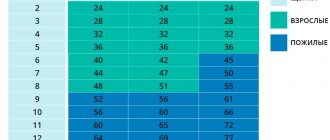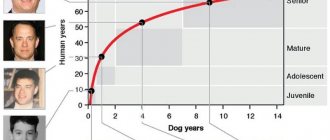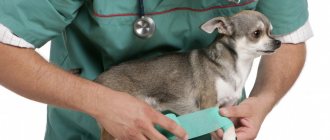How to tell a dog's age by its teeth? Dogs are very loving animals of the world and they also have a life period. It depends on the breed of dog they will live according to their lifespan, we can also see that there are some big dogs with a long lifespan. The age of any dog is easy to determine. You can explore by observing your dog's developing teeth.
They have exceptional qualities and their teeth easily explain their age. But by looking at puppies, age can be determined with greater accuracy. In adult dogs this becomes difficult to determine. But for any dog it only gives a rough estimate. Some points will help you to know how to predict the age of any dog, be it an adult or a puppy.
Age table
- By 8 weeks : all baby teeth are intact.
- By 7 months : All permanent teeth should be white and clean.
- By 1-2 years : Teeth will become dull and back teeth may yellow slightly.
- By 3-5 years : Tartar will begin to form on the molars, and the teeth will wear out a little.
- 5-10 years : Teeth will show wear and tear, causing signs of disease to appear.
- By age 10-15 : Teeth are worn down and tartar will remain on their teeth. Teeth may be broken or missing.
| AGE | DEVELOPMENT OF TEETH |
| 3-4 weeks | Growing temporary fangs |
| 4-6 weeks | Temporary incisors and premolars |
| 8 weeks | Has all primary teeth (24) |
| 3-4 months | Temporary teeth begin to fall out, but there are no permanent teeth |
| 5-7 months | Constant growth of incisor, premolar and molar |
| 7-9 months | All permanent teeth have grown |
| 1 year | Clean white teeth |
| 1-2 years | Back teeth begin to fade |
| 3-5 years | Dentures show tartar and slight wear |
| 5-10 years | Wear and tartar are noticeable. |
| 10-15 years | Teeth are worn down with a lot of tartar and some teeth may be missing |
Comparison of human and canine ages
Knowing the average life expectancy of a person and a dog, it is easy to determine the conversion factor as 7 human years for 1 dog year. A rough estimate is given. In fact, the human age of a dog cannot be calculated using this scheme.
The puppy develops quickly. In the first year of life, he manages to catch up with the development of a 16-year-old teenager. For this reason, puppies receive increased attention. It is recommended to devote a lot of time to education and proper feeding, or time will be lost. The exact age of a puppy is easy to determine by observing its developmental stages. At 2 years old, the dog will be 24 in human years. Then maturation slows down.
Medium and small pets age more slowly than large and giant pets. Medium-sized dogs are considered to have longevity; traumatic injuries to dogs are less likely. Small pets go through 5 human years per year, large ones – 6, and largest ones – 7 years.
14 years of a large dog - 108 human years. The relationship between the age of the dog and the person helps determine the rules of care. From the age of 8, dogs are considered to be old; indeed, at the age of 55-66 people retire, their workload decreases, and their diet changes. The coefficient shows that small breeds are able to live longer.
Predicting the age of dogs by teeth
Judging the Age of Puppies by Their Teeth Growth: You can see that newborn dogs are not made of teeth, but after three to four weeks you can see the first teeth grow, and then after 4 to 5 weeks you will see the incisors appear. Then, in the sixth week, you can watch the molars burst.
It can be seen that in the 8th week you will notice that all your teeth are growing back. You may see 28 baby teeth, but after four months you will see all the teeth fall out. Then you will see that after seven months you will be able to observe 42 teeth of an adult dog. Dogs have certain periods when their puppy teeth grow and then fall out. Then, in the same way, the teeth grow again, which are adult teeth.
Dog dental formula
A healthy adult dog has 42 teeth: 20 teeth on the upper jaw and 22 on the lower jaw. Sometimes there are animals with insufficient teeth - oligodontia - or, conversely, with extra teeth - polyodontia.
All teeth are divided into 4 types: incisors, canines, premolars and molars. A schematic record showing the type, number and location of teeth in the mouth is called a dental formula. The types of teeth in the dental formula are designated by Latin letters: I – incisor (Incisivi), C – canine (Caninus), P – premolar (Praemolares), M – molar (Molares).
Thus, the dental formula of an adult dog will look like this:
2M 4P 1C 3I 3I 1C 4P 2M
3M 4P 1C 3I 3I 1C 4P 3M
The top line indicates the upper jaw: 2 molars, 4 premolars, 1 canine and 3 incisors on the right and left sides. The bottom line shows the arrangement of teeth on the lower jaw: 3 molars, 4 premolars, 1 canine and 3 incisors.
How to estimate the age of an adult dog
Assessing the maturity of any dog is easy. In the first year of adult teeth, you will see that their teeth are white, but by the end of the second year, you will see that their white teeth will become dull, and then tartar will appear on their white teeth. They will begin to turn yellow and the teeth will become covered with tartar.
Within three years of age, you will see dogs have yellow teeth with brown tartar and may also develop bad breath. But after three to five years, you will notice that the yellow color has completely spread to all your teeth. You will see wear and tear on their teeth, and tooth wear increases as they age. The gums will then pull out from the teeth and the gums will be exposed, leading to gum loss.
Some precautions for wear and tear on growing teeth : Teeth staining can change the color of teeth from yellow to brown. But then, after 5-10 years, wear and tear will begin on the teeth, which will show signs of disease. Gradually, decay will become widespread and teeth will begin to disappear. There are several ways to slow down the wear and tear of teeth by making them eat good food with good habits and also take medications. This should be done daily, this will help them have good teeth and taking care of your dog's oral health will lead to healthy dog teeth.
According to other signs
How to determine the age of a kitten: basic methods and calculation options
In addition to the condition of the teeth, there are several other external signs by which you can understand how to find out the age of a dog without documents: by the condition of the muscles, fur and eyes.
It should be taken into account that large dogs (German shepherds, huskies and others) age faster than small ones. Upon reaching the age of 10, dogs' immunity weakens and they are more susceptible to various diseases. Caring for older pets should be more thorough.
According to muscle condition
This sign allows you to determine only the approximate age. Young dogs are active and energetic. They love outdoor games and willingly frolic while walking in the fresh air.
Adult dogs behave more passively. During walking, they prefer to walk rather than run, need rest more often and sleep longer.
Adult dogs need long periods of rest to recuperate.
Lifestyle affects the physique of pets. The muscles of adult dogs become flabby and begin to atrophy. The fat layer increases. For those who don’t know how to determine a dog’s age by the state of its muscles, just touch the body. The muscles of the young dog are hard and elastic.
Important! To avoid the development of obesity in an adult dog, you must strictly adhere to the feeding regimen and portion sizes. When using a ready-made diet, you should choose food that is appropriate for the age of your pet.
According to the condition of the coat
The appearance of the coat is also an additional, but not the main sign for determining the age of the dog.
The condition of the coat is strongly influenced by the nutrition and care of the pet. The coat of young dogs is bright, soft and shiny, while that of older dogs is hard and brittle, with a less saturated color. As the coat ages, it becomes uneven, tangles form more often, and dirt accumulates more quickly.
Facial hairs usually begin to turn gray after age 6. But in some dogs this sign appears as early as 3 years of age due to metabolic disorders.
By the eyes
A dog's eyes also indirectly indicate its age. Young dogs' eyes sparkle and express puppy delight. In adults, the eyes become cloudy and the color of the iris becomes duller. Vision deteriorates with age, and lacrimation is more common. Some breeds tend to have deepening eyeballs as they age.
The puppy's eyes are pure and innocent, with bright color
The order of changing teeth
IMPORTANT! In dogs, the replacement of baby teeth with permanent ones does not occur in the order in which the baby teeth appeared.
The very first incisors to fall out are the hooks, followed by the middle ones and the edges. This happens around the 4th-5th month of a dog’s life. After this, the first molars, located immediately behind the premolars, erupt. At the age of six months to 8 months, primary premolars are replaced by molars. Around the same time, they are replaced by molars and canines. The last to erupt are all the remaining permanent molars, which were not primary molars.
Large dogs acquire teeth faster than small breed dogs. This happens because the milk teeth of small dogs do not have time to fall out before the permanent ones begin to grow. Therefore, small dogs need to have their teeth examined regularly in order to be able to identify abnormalities in time.
IMPORTANT! During the change of teeth, the immune system of dogs decreases. Therefore, dogs should not be vaccinated during this period of time.
Characteristics of grin
Provided the dog is healthy, its grin should contain 42 strong, permanent teeth. If there are more or fewer teeth, this indicates that some disturbances or mutations occurred at the genetic level during the intrauterine development of the puppies. The color of permanent teeth should be white when they erupt, then during life it becomes slightly yellowish.
The bite of different breeds of dogs differs from each other. A bite is considered normal when the upper incisors cover the lower ones. Any changes are considered pathology. In adult dogs, dental crowns gradually wear off and fangs wear down. If the bite was correct, then the wear occurs the same and does not affect the quality of the dog’s life.
Frequency of teeth changes
Change of baby teeth in dogs of all breeds occurs only once in their entire life. There is no change of molars. If a dog over 1 year old has lost a molar tooth, this indicates a health problem and the need for an examination.
Signs of teething
Puppies teething without pain. The only unpleasant symptom in this process is itching of the gums. That's why puppies chew everything that gets in their way. To protect your belongings from gnawing, you should purchase special toys and treats for dogs in advance. When you visit a pet store, you can easily choose a toy to scratch your pet’s gums. In addition to itchy gums, signs of teething in puppies include a slight increase in temperature, some weakness, and sometimes a decrease in appetite. There are cases of diarrhea. It is best to visit a veterinarian to understand whether everything is okay with the dog.
Basic principles
The principle of determining the age of a puppy or dog is based on the basic patterns of the eruption of baby teeth, their erasure, and then the appearance of permanent teeth and their erasure. Newborn puppies, of course, do not have any teeth. In older individuals, teeth wear down differently, it all depends on the diet and health of the animal. In determining the age of a dog, the incisors play the most noticeable role - each such tooth (more precisely, its crown) acts as three points (fields, teeth, points). It is important to remember that in most cases, both lateral incisors wear down over time to the point that they simply disappear.
Alternative methods for determining a pet's age
The age of a pet, in addition to the condition of its teeth, can be determined using other methods
. The only significant drawback is their low reliability.
As a rule, an older pet already has gray hair. Their number is constantly increasing in accordance with the age of the dog. The first gray hair appears in a pet at the age of 6 years. However, this manifests itself individually for each pet.
In addition to gray hair, older dogs begin to have cloudy pupils and deeper seating of the eyes.
. Most owners note a decrease in visual acuity in their pet.
A drooping belly, arched back and dull coat are also signs of an older animal.
Thus, using all the methods, you can easily determine how old your pet is. In this case, not all signs may be present at the same time, but only some of them. A huge role here is played by the dog’s lifestyle, its nutrition and quality care, that is, a lot depends on the owner.
Note that when determining the age of small breeds, experts identify several features
. The fact is that such middle-aged dogs are practically no different from ordinary puppies. This is especially noticeable in a toy terrier puppy. After a month of life on their head, their hair roots have a golden tint. While the coat of an adult pet will be completely golden brown.
In small dogs, color may vary individually. Therefore, determining age based on the condition of teeth will be much more accurate and effective than using other characteristics.
With the help of such signs, each owner will be able to determine how old their four-legged friend is without much difficulty. If you do not have a passport for the animal, you can obtain more detailed information by contacting the veterinarian or the breeder from whom the pet was purchased.
To prolong a dog’s life, it is necessary to provide it with quality care and nutrition.
. In the case when a dog is many years old, this does not mean that his days are numbered. Often, an adult animal still lives for a long time, while leading an active lifestyle.
Often a dog ends up in a family without documents. The pet is found on the street or received from previous owners who did not care to provide the necessary information about the animal. In such cases, the new owner has to make every effort to find out how to determine the dog’s age. Knowing how old the pet is, the dog owner will be able to promptly take the necessary measures that will prolong the life of the pet and preserve its health. There are several ways to determine age by external signs.
- First of all, information about the age of the animal will be useful when visiting the veterinarian. Many diseases can only develop after a dog has lived a certain number of years. The age of the pet helps the doctor establish a more accurate diagnosis and timely prevent certain diseases;
- When vaccination, this information is no less important. Vaccinations are given only in accordance with age. Young animals are required to receive annual vaccinations. For adults, this procedure is done once every two years. As your dog ages, the time between vaccinations increases. This is due to the fact that the immune system is depleted and the vaccine can cause harm to the animal’s body;
- For owners planning to get puppies from their dog, knowing the age is necessary to determine the best time to breed. Based on this parameter, they find out whether the bitch is still suitable for reproduction;
- You will need information about age and sterilization. Some owners carry out this procedure on their pet when it is still young in order to avoid the appearance of puppies and the inconveniences associated with the rutting period. Other owners send older pets for surgery to prolong their life and avoid the risk of developing diseases inherent in older dogs. Sterilization both at an early age and in older dogs can negatively affect their health. If the owner decides to sterilize an adult dog, it is better to have it operated on at 6-7 years of age;
- For volunteers who place dozens of different foundlings in new families, the ability to determine the age of a dog by external signs is one of the most important tasks. When transferring a dog to a new home, they try to give the most complete information about the animal to the new owners;
- Choosing the right diet also directly depends on the age of the dog. Even industrial feeds are created taking this parameter into account.
conclusions
The age of a puppy can be determined by the developmental phase of its grin. This is difficult to do in small breeds. The age of an adult dog is determined by the degree of wear (abrasion) of the teeth. Dogs whose oral cavity has been looked after remain with a healthy grin longer. For comparison with the examination data of the animal under study, we use the dental formula.
Please follow and like us:
Nikitin Sergey
I write about dogs based on the experience and knowledge gained during my studies as a veterinarian, work in my specialty, and simply from observing my pets.
Life expectancy and age groups
Dogs live on average from 9 to 20 years. This factor largely depends on the size of the animal. Small breed dogs usually live to older ages than their larger counterparts. Giant dogs such as mastiffs, Great Danes and St. Bernards have the shortest life cycle. There are three main groups into which all dogs can be roughly divided:
- puppy;
- young animals;
- adult representative of the species.
Technically, a dog can be considered a puppy for the first two months of its life
From the moment of birth until 8 weeks, the animal is considered to be a puppy. From this age until reaching 18 months - young animals. Dogs over this age are considered adults.
How many live on the street and at home?
German Shepherds that live outdoors have a longer lifespan than those that live indoors.
This is due to the characteristics of the breed itself. Germans need physical activity, in which it is difficult and impossible to limit them, as well as mental activity, which manifests itself in training.
If you take away these aspects of your dog's life, it will have a negative impact on their physical and mental functioning.
The dog may become aggressive, its muscles will begin to weaken, and it will no longer be able not only to stand up for itself, but also to protect its owner.
If a German Shepherd is constantly kept in an enclosure on the street, this will lead to the same consequences.
Many dog breeds, on the contrary, feel more comfortable indoors, but the German Shepherd is not one of them. It is better and healthier for her to be outside - she is not afraid of rain and cold because of her dense undercoat and good coat.
Therefore, we can say with confidence that dogs living in the courtyard of a private house live much longer than those who have to huddle in an apartment.
But this does not mean at all that a German Shepherd cannot live indoors . Just provide her with the right amount of physical and mental stress.
Look into your eyes
If you look into the dog's eyes, you can also draw conclusions about how old he is. In young pets they are always clean, clear, without any veil or discharge.
Over time, the eyes begin to fade and become cloudy. This happens gradually. At about 4-5 years old, they are no longer so lively, their enthusiasm disappears and some fatigue begins to appear. Also during this period they begin to become cloudy and dull.
In an animal over 8 years old, the eyes may be covered with a kind of veil, they lose transparency and look tired and dull. If we talk about diseases of the organs of vision, they most often appear in dogs towards old age.
In order to determine the dog’s age as accurately as possible, you need to pay attention to the set of milestones and compare them. But still, the best option is to show the animal to a specialist.
What is it for?
There are many reasons why you might need to determine the approximate age of your pet. Here are the most common ones. The age of the dog is very important for timely vaccination, since more vaccines are given at certain times. Thus, at a young age, vaccination is carried out every 12 months. And already in adulthood, your pet needs to be vaccinated much less frequently so as not to harm its health, since as it ages, the immune system becomes more vulnerable. Having information about the age of your pet, you can calculate the mating period.
When deciding to undergo spaying and castration surgery for your pet, it is important to choose the appropriate period and not harm him. The most suitable period, according to veterinarians, is 6-7 years. Features of caring for a dog depend on its age. Therefore, with this information, you can provide her with the most suitable conditions to maintain her health. In case of loss of your pet’s personal documents, the procedure for establishing the age of the four-legged animal is inevitable to confirm the information you provided.
Check out the premium and super-premium food ratings and find out whether you can give your dog dry food.
Visual inspection
This method of assessment is used if it is not possible to conduct a full examination of the animal or when encountering an aggressive, presumably stray, dog. The correct determination of age will allow you to build the correct behavior with the dog, which will differ for a young puppy expressing a desire to play or with an elderly dog who may have undergone mental changes.
When visually assessing, attention is paid to the following features:
- Muscle tone. A young dog has an elastic, strong, lean body, the muscles are not yet developed, the chest is narrow. The adult individual is noticeably different; it has an expanded chest, bonyness, which is clearly visible in the ridge area, or is overweight due to a sedentary lifestyle; gray hair may also be noted on the face.
- Activity. If the movements are energetic, then the dog is young. Difficulty moving is characteristic of old age.
- The fur of a young individual is thinner and softer, while that of an adult is often thick and coarse.
- The eyes of young animals are clear and bright; with age they become dull and cloudy.
Features of different breeds
When determining a dog's age, it is important to consider its breed. Small, medium and large animals have different life expectancies, which is reflected in the speed at which they grow.
In small
Small dogs (Spitz, Chihuahua, Yorkie) are long-lived. Puberty in such pets occurs early - at six months. But teeth take a very long time to form – up to 11 months.
In the middle ones
This group includes breeds reaching 10-25 kg (Shar Peis, French bulldogs, cocker spaniels). Their puberty lasts up to 1.5 years, and molars appear by 9 months.
In large
Dogs whose weight exceeds 25 kg live shorter than all others. Despite their impressive size, they remain puppies until they are almost 2 years old. Their average lifespan is 8-10 years, so after a long growth phase, a fairly rapid aging of the body is observed.
Stages of life
- First stage: childhood. Lasts approximately six months after birth. During this time, the kitten learns about the world around it and its dangers, and constantly receives new information. For now, he walks next to his mother, who teaches him everything and protects him from dangers. At the end of the first stage of a cat's life, we have an 8-12 year old child.
- Second stage: youth. Lasts from six months to two years. Feline puberty, period of growing up, puberty. By the age of one year, the cat is already biologically ready to give birth, but it is better to wait until two years - by this time she has acquired all the vital skills and abilities.
- Third stage: youth. Peak of development and activity. It lasts from three to five years. The cat is playful, intelligent, inquisitive and very active. Ready to reproduce healthy offspring. If we compare this with human life, then here we are no longer a teenager, but a young man who has graduated from university and found a good job.
- Stage four: maturity. From the seventh to the tenth year of life. The cat becomes cynical and indifferent in its views on the world; it worries it less. More time is spent sleeping, and the animal’s gaze itself becomes disdainful and proud. The cat is still healthy and has a lot of energy, but she no longer has much desire to waste it on stupid games.
- Fifth stage: retirement. It is only thanks to today's veterinary advances that cats have begun to discover this magnificent stage of their lives en masse. Now they enjoy life like people of about 60-70 years old. Such animals live exclusively for themselves and for their own pleasure. They sleep, eat and look at the birds in the windows for a long time, no longer trying to catch them, no longer getting nervous.
- Sixth stage: old age. Cats at 15-16 years old are already considered long-lived. If your pet or pet survives to this stage, you are lucky. During this period of life, they become affectionate, faithful, and require more attention, love, care and warmth.
https://youtube.com/watch?v=sffK5XP0Bfw
Possible complications
- Malocclusion
Dogs with long muzzles often face malocclusion problems. They have regular-sized teeth growing on narrow gums. Also, the cause of malocclusion may be teeth changing out of order or a person interfering. To avoid this, it is necessary not to suddenly tear objects out of your mouth during games. If an abnormal bite is found in an ordinary domestic dog, then nothing is done about it and left as is. If the problem occurs in a show dog, this is a big disadvantage. In this case, special braces are placed under anesthesia and the bite is leveled.
- Gum inflammation
A slight inflammation of the gums does not leave the puppies throughout the entire period of changing teeth. The gums become reddish and swollen, and salivation increases. Appetite often decreases due to pain in the gums. This process generally does not require assistance. The only thing you should do is give up rough food so as not to injure your gums. If you notice any complications, it is better to contact your veterinarian. The doctor will prescribe medications to sanitize the dog’s mouth.
- Delayed tooth change
It happens that baby teeth have not yet fallen out, but molars are already growing in their place. This can lead to malocclusion, as well as unnecessary damage to the cheeks and gum inflammation. If you notice this case in your pet, then you should try to help the baby tooth fall out at home. If unsuccessful, you need to take the dog to the veterinarian so that he can remove the tooth under anesthesia. If this is not done in time, you will eventually have to undergo surgery.











